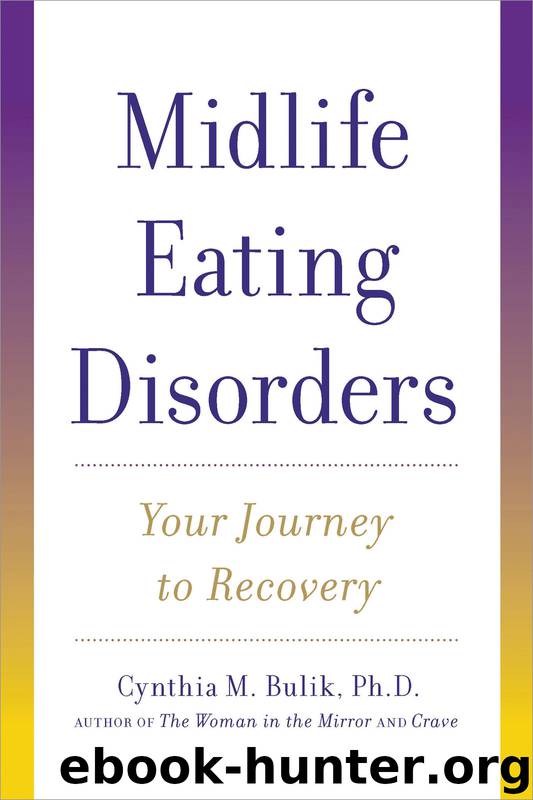Midlife Eating Disorders by Cynthia M. Bulik Ph.D

Author:Cynthia M. Bulik, Ph.D.
Language: eng
Format: epub
Publisher: Walker Books
Published: 2013-03-09T16:00:00+00:00
Eating Disorders and Fertility
Human fertility is the end point of a number of complex biological and psychological systems, many of which are disrupted by eating disorders. Energy metabolism, body weight, nutritional state, and reproductive physiology all converge and interact to influence human fertility—in both women and men. Although it is entirely sensible, few people appreciate that appetite and reproductive hormones act in a delicate balance. From a survival perspective, adequate nutrition is important for conception and to ensure robust sperm production. Eating disorders can interrupt fertility in several ways.
The Impact of Eating Disorders on Menstruation. As discussed in Chapter 2, in the old DSM-IV system, amenorrhea, defined as the absence of menstruation for at least three consecutive cycles, was a diagnostic criterion for anorexia nervosa. Extensive research has culminated in the abolition of this criterion in DSM-5, in part because it is so difficult to identify amenorrhea today with so many different contraceptive options, many of which eliminate menstruation entirely; because amenorrhea never applied to men or postmenopausal women; and because copious research revealed that individuals with all of the symptoms of anorexia except amenorrhea did not differ in any meaningful way from women who did experience it.1
Even though it is no longer a diagnostic criterion, amenorrhea and oligomenorrhea (irregular menstruation) are common in anorexia nervosa, as well as in bulimia nervosa and BED—despite the fact that these disorders typically occur in individuals who are normal weight or overweight. Clearly, more than just BMI influences menstrual irregularity in eating disorders. Disruptions to otherwise regular menstruation are loud signals that something is biologically amiss.
There are several ways to approach the question of infertility in women with eating disorders. One is to determine the percentage of women seeking fertility treatment who have or have had eating disorders. Although a worthwhile approach, it is complicated by the fact that women with eating disorders may be hesitant to reveal this to a clinician or researcher if their partner is unaware of the eating disorder, or for fear that their provider may delay or withhold fertility treatment. With this caveat in mind, two studies have revealed that between 16 and 20 percent of women seeking fertility treatment have eating disorders, which is markedly higher than the prevalence of eating disorders in the general population.2
Another measure of infertility is the length of time it takes to get pregnant while engaging in unprotected sex. The typical window for conception in women in the reproductive years is about three to six months, and a fairly standard definition of infertility is the inability to conceive after twelve months of trying. In a study of 14,663 women in the United Kingdom, women with histories of anorexia or bulimia nervosa were more likely to have sought fertility treatment than women with no histories of eating disorders.3 But bear in mind that the only women in this study were women who had already become pregnant, so any women who had tried unsuccessfully would not be accounted for. Another study of women with
Download
This site does not store any files on its server. We only index and link to content provided by other sites. Please contact the content providers to delete copyright contents if any and email us, we'll remove relevant links or contents immediately.
50 After 50 by Maria Leonard Olsen(1698)
The Middle Passage: From Misery to Meaning in Midlife by James Hollis(1659)
Dirt by Bill Buford(1649)
1610396766 (N) by Jo Ann Jenkins(1642)
Manipulation: A Guide to Mind Control Techniques, Stealth Persuasion, and Dark Psychology Secrets by Deborah Weiss(1484)
The Age of Miracles by Marianne Williamson(1470)
Persuasion: Learn Techniques in Manipulation, Dark Psychology, NLP, Deception, and Human Behavior by Tori Dasani(1446)
Between Them by Richard Ford(1297)
Secret Life of the Grown-Up Brain by Barbara Strauch(1256)
Love and Trouble by Claire Dederer(1250)
Finding My Badass Self by Sherry Stanfa-Stanley(1250)
The Minimalist Mindset: The Practical Path to Making Your Passions a Priority and to Retaking Your Freedom by Danny Dover(1217)
I Miss You When I Blink: Essays by Mary Laura Philpott(1204)
In Our Prime by Patricia Cohen(1153)
A History of the Popes: Volume II: Middle Ages to the Protestant Reform by Wyatt North(1148)
The Change by Germaine Greer(1140)
Fear of Fifty by Erica Jong(1118)
The Art of Not Falling Apart by Christina Patterson(1105)
Your Story Matters by Leslie Leyland Fields(1085)
